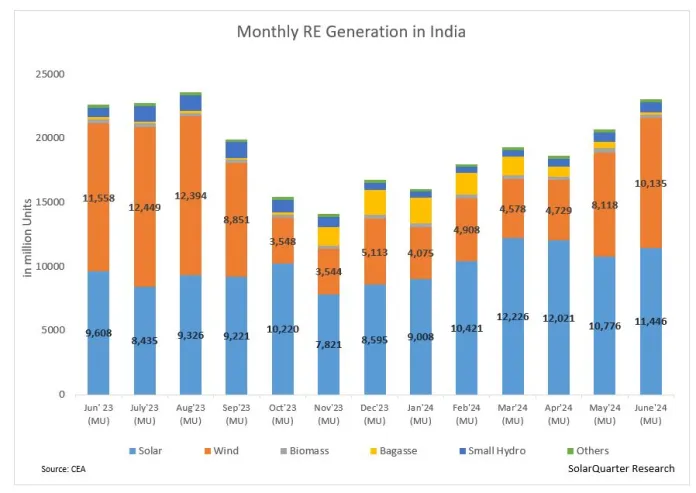In June 2024, India reached a noteworthy achievement in its renewable energy sector, with solar power contributing to nearly half of the nation’s renewable energy output.
Solar energy alone constituted 49.65% of the total renewable generation, underscoring India’s unwavering commitment to sustainable energy practices.
The country’s cumulative installed renewable capacity, excluding hydropower, reached 148.084 GW.
Solar and Wind Power Drive Growth
The rapid expansion of solar power is evident, with an installed capacity of 85.474 GW. This growth is largely attributed to supportive government policies and initiatives that promote clean energy adoption.

Wind energy also played a significant role, comprising 43.96% of renewable energy generation and producing a total of 10,134.92 million units during the month.
Wind energy’s installed capacity stands at 46,656.37 MW, demonstrating India’s abundant wind resources and ongoing investments in wind projects.
Diversification of Renewable Energy Sources
Biomass, bagasse, and small hydroelectric projects accounted for 5.37% of renewable energy generation in June. This diversification of sources contributes to reducing the nation’s dependence on fossil fuels.
The total renewable energy generation, excluding hydropower, reached 23,052.28 million units, showcasing the progress made in expanding renewable infrastructure and incorporating these sources into the power grid.
Aligning with Global Sustainability Goals
India’s emphasis on renewable energy is in line with international sustainability objectives and climate change mitigation efforts.
By prioritizing solar, wind, and other renewable sources, India aims to reduce carbon emissions, enhance energy security, and drive economic growth.
The growth of solar and wind power in June is a testament to the success of government incentives and technological advancements, which have made clean energy more accessible and cost-effective.
Ambitious Targets and Future Outlook
India has set ambitious goals to achieve 500 GW of renewable capacity by 2030. To maintain this momentum, addressing challenges such as grid integration and financing will be crucial.
Collaboration among government bodies, industry stakeholders, academic institutions, and civil society will be essential in realizing India’s full potential in renewable energy.
A Major Step Towards a Sustainable Future
The dominance of solar and wind power in June 2024 marks a significant stride towards a cleaner and more sustainable energy landscape for India.
This shift not only addresses environmental concerns but also fosters economic development and ensures energy security.
As renewable capacity continues to expand, particularly in the solar sector, India solidifies its position as a global leader in renewable energy. The integration of energy storage technologies will further enhance the reliability and stability of renewable sources, propelling India towards a greener and more resilient economy for future generations.